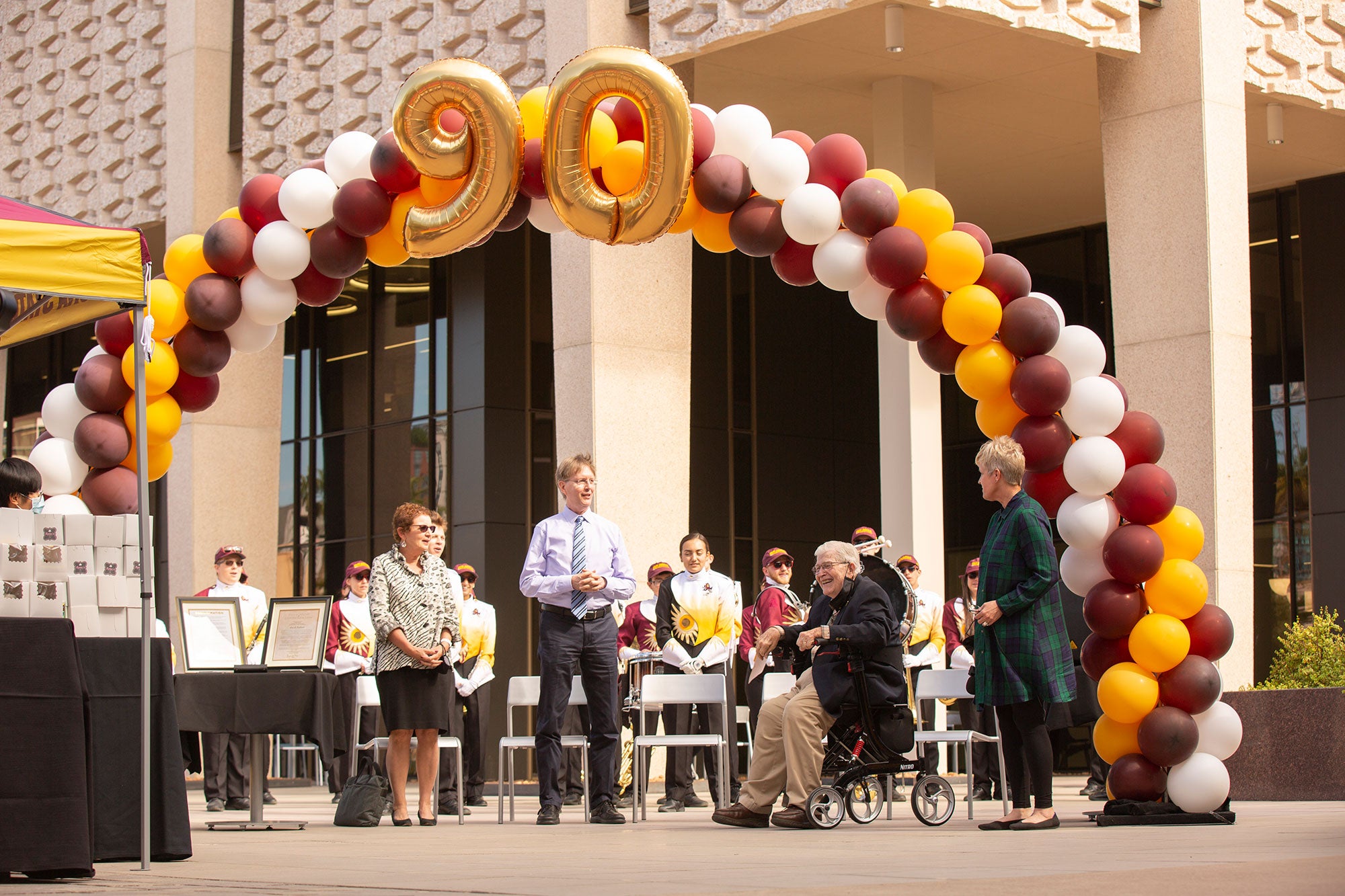ASU celebrates 90th birthday of engineering school's namesake, Ira Fulton

Ira Fulton smiles at an ASU event celebrating his 90th birthday, which falls on Nov. 12. The event, held on Nov. 9, included performances by the ASU marching band and spirit squad, a cupcake giveaway and a proclamation by Tempe Mayor Corey Woods. Photo by Erica Gronek/ASU
On his 90th birthday, Ira Fulton has a lot to celebrate. For decades, the businessman and philanthropist has made an indelible mark — accomplishing professional goals, fulfilling personal ambitions and making a positive impact around the world through a diverse range of endeavors.
This week, Arizona State University recognizes the major benefactor and namesake of the Ira A. Fulton Schools of Engineering at Arizona State University, the success he has achieved and how he has used the fruits of his labors to help better the lives of others.
Fulton’s support for communities and causes that align with his strong personal values has grown at every stage of his climb to fortune in the business world. His immense spirit of generosity shines brightest in the hundreds of millions of dollars in donations he has made to institutions of higher education.
At the recent public event on ASU’s Tempe campus to celebrate his upcoming birthday, Fulton was presented with an official commendation signed by Arizona Gov. Douglas Ducey and a proclamation signed by Tempe Mayor Corey D. Woods.
Both documents cited Fulton’s exceptional contributions to enabling students improve their lives through education, along with the business investments and successes of his company, Fulton Homes, that have helped to foster strong communities and economic opportunities for Arizonans.
In the city’s proclamation, Mayor Woods declared Fulton’s birthday, Nov. 12, this year as Tempe’s official “Ira Fulton’s 90th Birthday” commemoration day.
The joy Fulton gets from what his contributions have made possible for younger generations can be witnessed in the broad smiles, laughter and exuberance he exhibits when gathering with students at the various ASU events he attends each year.
On those occasions, Fulton will often enthusiastically share with students the insights he has gained over many decades of experience in facing life’s challenges.
So, in celebration of his 90th birthday Nov. 12, we offer a list of nine biographical highlights.
1930s
Ira Fulton was born in Tempe and would grow up in a small home a little more than a block away from the future site of the Brickyard, the building that is now the headquarters of ASU’s Ira A. Fulton Schools of Engineering.
As a child, he washed dishes in his mother’s cafe.
1940s
Fulton’s first steady job — and management position — came when he was just a teenager. He worked as a newspaper carrier for The Arizona Republic, serving more than 500 customers each day, picking up papers at dawn for his morning route, as well as for the routes of the carriers he supervised.
Late 1940s to early 50s
Fulton’s early full-time jobs included work in gas stations and at auto parts and tire stores.
It was during this time that he began attending Arizona State College (many years before it became Arizona State University) on a football scholarship.
1950s to 70s
After college, Fulton’s indisputable business acumen became apparent as he began his journey of making a wide range of ventures profitable, including companies focused on cash register sales, computer services, men’s clothing and homebuilding.
1970s
In 1975, he founded Fulton Homes, which became one of the Phoenix metropolitan area’s largest homebuilders and, to date, has developed more than 60 residential communities.
1970s to the 2000s
As his business empire grew, Fulton began to make his mark as a generous philanthropist to charities, educational institutions and non-profits across the country. In addition to his contributions at Arizona State University and Brigham Young University, Fulton made significant donations to the YMCA, the Boy Scouts of America, American Indian Services, a cancer foundation and The Church of Jesus Christ of Latter-day Saints. During this time, Fulton pledged to donate a considerable percentage of the profits from Fulton Homes to various organizations.
In 2003, the Fultons donated $50 million to establish the Ira A. Fulton School of Engineering (later to become the Ira A. Fulton Schools of Engineering).
2006
Fulton was designated as one of Businessweek magazine’s “50 Most Generous Philanthropists.” The recognition was one of many such accolades for his substantial contributions to a variety of social and educational causes.
The same year, the Fultons donated $100 million to ASU, supporting multiple initiatives and renaming ASU’s College of Education the Mary Lou Fulton College of Education, in honor of Ira’s wife and college sweetheart, Mary Lou.
2010s
ASU’s Mary Lou Fulton Teachers College was established, merging the Mary Lou Fulton College of Education at the Tempe campus, the College of Teacher Education and Leadership on the West campus, and the School of Educational Innovation and Teacher Preparation on the Polytechnic campus.
The Arizona Legislature at one time gave special recognition to the benefits the Fultons’ generosity has brought to the people of the state.
During an interview with the Deseret News in Utah, Fulton told a reporter his most significant accomplishment was marrying his wife. He and Mary Lou were married for more than 60 years until her passing at age 82 in October 2015.
Today
Ira Fulton is a regular participant and speaker at various Fulton Schools events, from welcoming new students at E2, the immersive introductory experience for new engineering and technology students, to sending new graduates into the world at Fulton Schools Convocation ceremonies — encouraging them to pursue their highest aspirations as professionals and citizens.
Students, faculty and staff, including Fulton Schools of Engineering Dean Kyle Squires (center) gathered in front of Hayden Library on the Tempe campus on Nov. 9 to celebrate the 90th birthday of Ira Fulton (center right), the namesake of ASU's engineering schools. Photo by Erica Gronek/ASU
More Science and technology

Lucy's lasting legacy: Donald Johanson reflects on the discovery of a lifetime
Fifty years ago, in the dusty hills of Hadar, Ethiopia, a young paleoanthropologist, Donald Johanson, discovered what would…

ASU and Deca Technologies selected to lead $100M SHIELD USA project to strengthen U.S. semiconductor packaging capabilities
The National Institute of Standards and Technology — part of the U.S. Department of Commerce — announced today that it plans to…

From food crops to cancer clinics: Lessons in extermination resistance
Just as crop-devouring insects evolve to resist pesticides, cancer cells can increase their lethality by developing resistance to…

